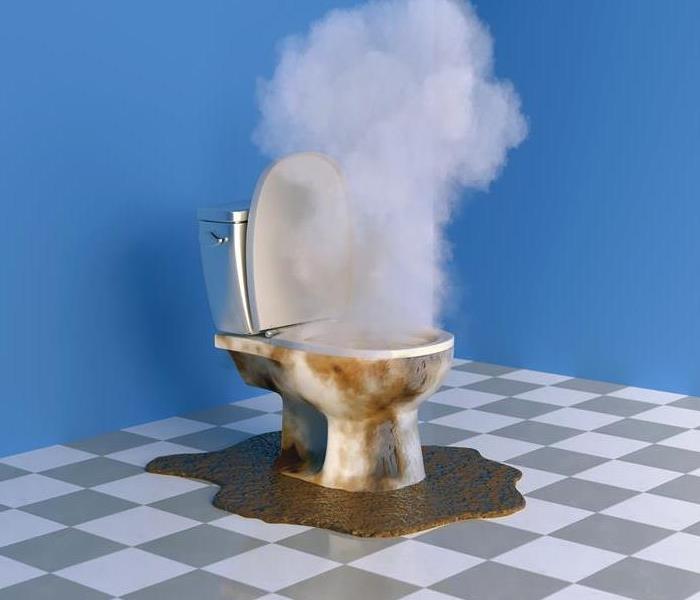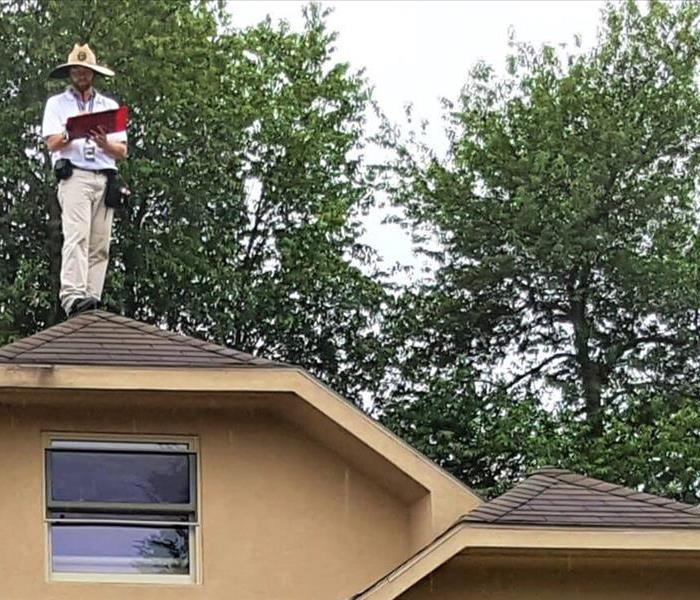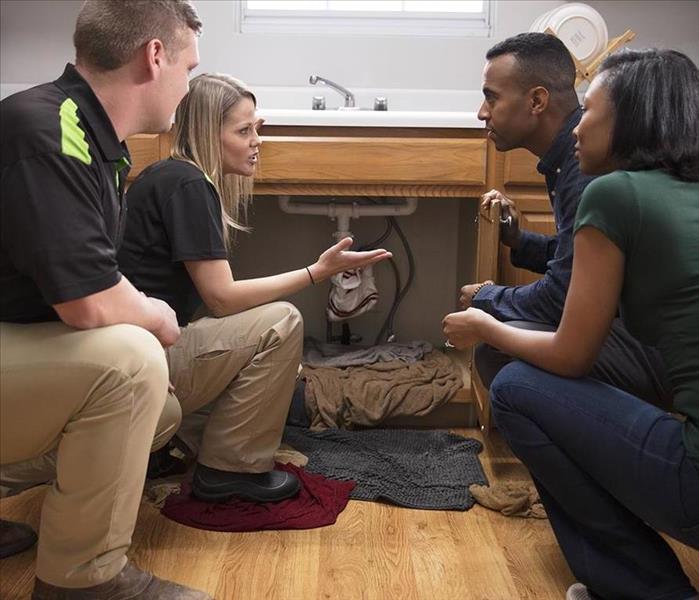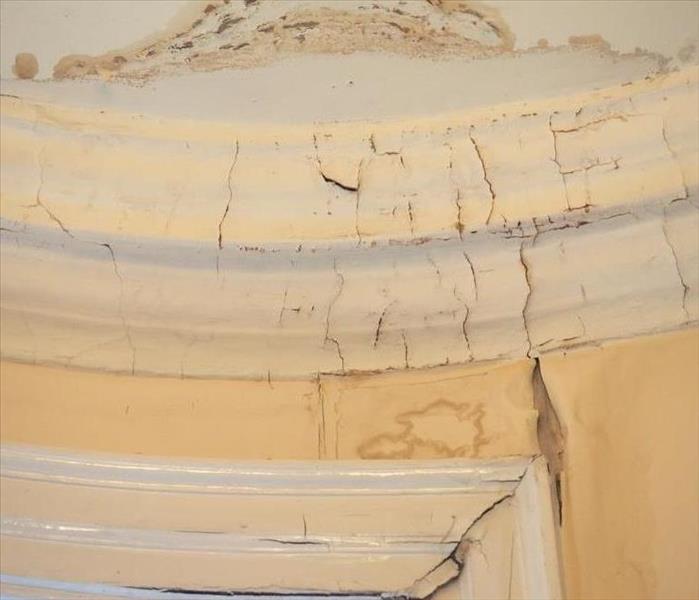Recent Water Damage Posts
Stay Away From Frozen Pipes This Year
1/22/2024 (Permalink)
Frozen pipes are a terrible thing to wake up to, but there are ways to avoid them completely! Follow our helpful tips this year to keep your home safe from the sub freezing temperatures.
Step 1: Know your home:
Are there pipes in your house that are more exposed than others? Is there a faucet that freezes every year? Keep things like this in mind. If your unfamiliar with your home because its new to you, or your first winter staying in it, take a minute to familiarize yourself with where your water access' are. Faucets close to an outside wall are more likely to freeze than those closer to the center of the home.
Step 2: Let the tap's drip:
When below freezing temperatures are expected, leave your faucets dripping a little until the temperature's return above freezing. Moving water takes longer to freeze and just a little movement goes a long way.
Step 3: Leave the heat on in your absence.
Leaving your heater on just above freezing while your away at work, or on vacation might be the life saver of your return. Although it can feel like we are waiting electricity, leaving the heat on just enough to keep our house above freezing internally can save you thousands on a water loss, and a huge headache on your return. In combination with leaving the faucets dripping your return should be a dry one even in these subfreezing temperatures.
Accidents happen all the time. When they do, leave it to the pro's at SERVPRO to help return your home to where it looks like it "Never Even Happened."
SERVPRO of Blackfoot Pocatello is open 24/7 365 and available anytime to help with your emergency! Call us at 208-242-3819.
SERVPRO of Blackfoot/Pocatello 24 Hour Emergency Water Damage Service
10/4/2023 (Permalink)
SERVPRO of Blackfoot/Pocatello is available 24 hours a day for water emergencies, large or small. When you are dealing with water damage, immediate action is crucial. A delay of just a few hours can greatly increase the severity of the water damage.
We Answer the Phone Ready to Help
Call Today - 208-242-3819
We understand that when you call us, you may be feeling confused, stressed, and vulnerable. You need an expert to guide you through this crisis. SERVPRO of Blackfoot/Pocatello has the specific water damage training and experience to help you through this tough time. We specialize in water damage restoration—in fact, it's the cornerstone of our business.
What to Expect
When you call, we will ask several questions regarding your water damage emergency. These questions will help us determine what equipment and resources to bring, including how many trained SERVPRO professionals may be needed.
Our SERVPRO Representative will ask several questions:
- Your name and contact information
- Your insurance information (if applicable)
- The street address of the water-damaged home or business
- When did the flooding or water damage occur?
- What caused the water damage (if known)?
- Is there electricity available (on-site)?
About SERVPRO of Blackfoot/Pocatello
SERVPRO of Blackfoot/Pocatello specializes in the cleanup and restoration of residential and commercial property after a fire, smoke or water damage event. Our staff is highly trained in property damage restoration. From initial and ongoing training at SERVPRO’s corporate training facility to regular IICRC-industry certification, rest assured our staff is equipped with the knowledge to restore your property.
So you have an ice dam....
3/8/2023 (Permalink)
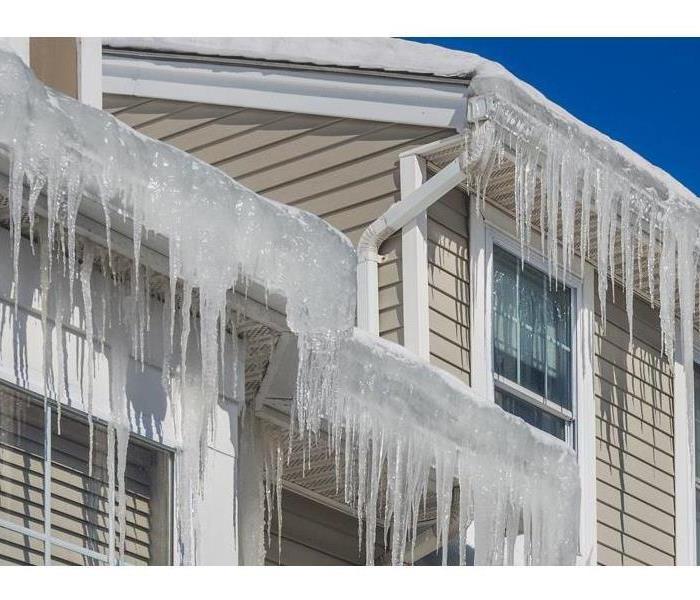 It's not just because of your gutters
It's not just because of your gutters
We've had several calls this season of Ice Dams causing extreme water damage in attics. So now what?
The main think to understand is that the cause of your ice dam is an improperly insulated attic. If heat is escaping into your attic, it's causing the snow closest to your roof to melt, and the snow on top to refreeze it. That will cause ice to form, and as we all know, ice EXPANDS. That means that any little crack can become a bigger crack once ice is introduced.
The solution to preventing ice dams is to make sure that your roof is properly insulated so that it doesn't cause the snow to melt from the inside out. You can also ventilate your attic by opening up any vents, and having the outside air circulate. Keeping your attic cool is important. Putting rock salt in your gutters can also help. If you're worried about your flower beds or lawn, putting the rock salt in pantyhose is beneficial.
So how do you get rid of an ice dam? That's not so easy, but it's possible. The first thing we recommend is calling in the professionals. It's can be dangerous to get on a roof that is covered in ice. A professional roofing company can come out and use their skills to remove that ice, while we come in and help you mitigate the damage on the inside.
We know it's a stressful situation, and we're Here To Help®, so give us a call and we can help you get it taken care of fast.
Basement Floods in Spring
1/23/2023 (Permalink)
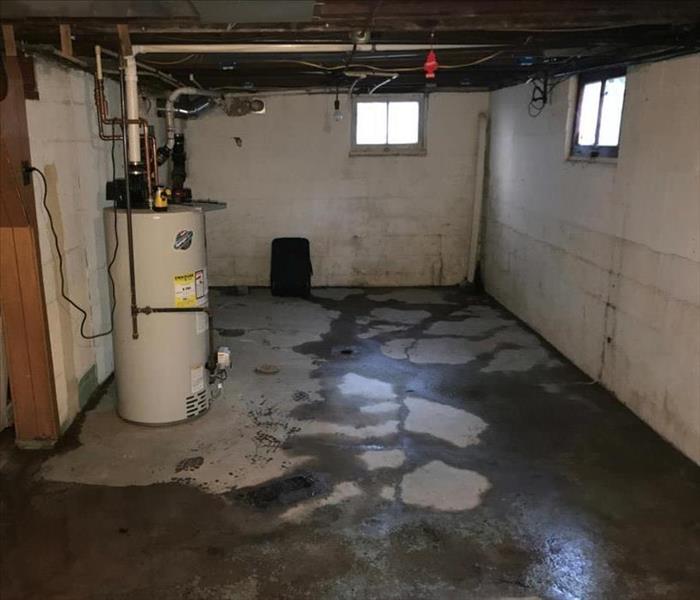 One simple crack can cause a lot of damage
One simple crack can cause a lot of damage
Springtime is coming up fast! That means that the ground is about to unthaw and all of that moisture that is surrounding your home is about to become a real problem if you have a crack in your foundation.
Wet and musty basements don't have to be a problem for you. Call us today and we can come in and dry it out and make sure you don't have to suffer this summer with a stinky moldy basement!
SERVPRO of Blackfoot/Pocatello can come in and find the source of water, and help you seal it off. Then we will dry everything out and make sure you're safe from future mold growth. Keeping your family safe and healthy is the primary goal!
Call us today, and we'll be there within two hours.
Preventing Water Damage While On Vacation
8/16/2022 (Permalink)
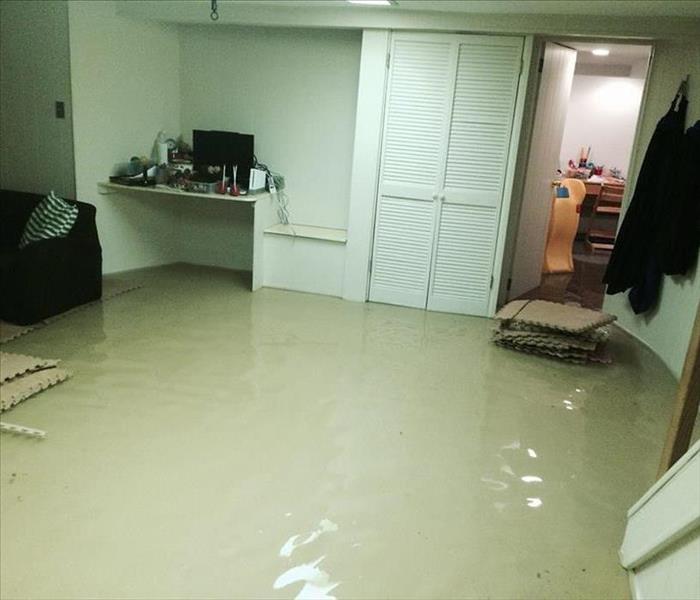 It's not a pretty sight to return to.
It's not a pretty sight to return to.
It's a nightmare scenario... coming home from vacation to discover your house is flooded from water damage. This scenario is all too common for homeowners, in fact, the Insurance Institute reports that water damage claims are the second most common claim. It's a disastrous problem. Can anything be done to prevent such a disaster? Here are 3 steps to prevent water damage while on vacation.
- Check Your Home | Before you leave, go and inspect areas where leaks could occur. Pipes in the kitchen and bathroom are especially important. Make sure there are no cracks or small leaks in the pipes. Check to make sure all pipes are secure.
- Clear Gutters & Downspouts | Clear away any blockages that could allow water to rest. Resting water in your gutter near your roof could cause water to leak through the roof.
- Shut Off Water Valve | When in doubt, turn your water valve off. This will prevent water from circulating in your pipes. If you live in an area with freezing temperatures, clear the pipes after you turn the water off to prevent the pipes from bursting.
A little preparation goes a long way in preventing a big expensive disaster. Nobody wants to return home from vacation to deal with a water damage.
Why Water Damage Needs To Be Cleaned Immediately
8/16/2022 (Permalink)
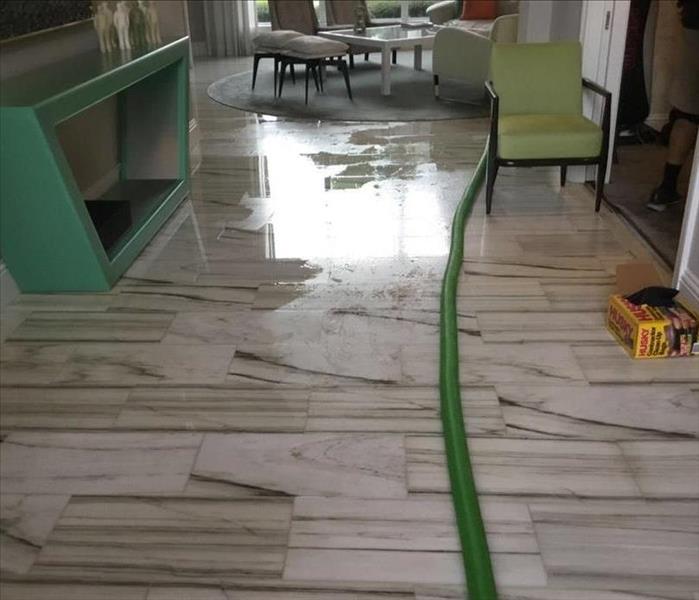 Cleaning it up doesn't have to be difficult.
Cleaning it up doesn't have to be difficult.
When flooding and other water disasters affect your home and family, you don't want to wait several hours for regular business hours. You need solutions immediately. SERVPRO water damage mitigation professionals offer 24-hour emergency response services. This means that if a pipe bursts on a holiday, technicians are available to respond. If heavy storm damages leave your home exposed to flooding, a fast response could prevent further harm.
You Can't Wait a Single Day
The first hours after your home is affected by water damage, many things begin to happen.
- Furniture swells and breaks down.
- Metal items tarnish and rust.
- Fabric and paper items become stained.
- Mold or mildew takes hold.
- Drywall weakens and swells.
An immediate response puts the progression of damage on hold while a corrective course of action is put into place.
It's Expensive To Delay
Many situations requiring cleaning and restoration must be addressed immediately. This is because water damage takes place within minutes. Within a short 60-second period, walls, floors, and upholstery absorb water. Finishes on tables and chairs begin to bleed. Cherished photographs start to warp and discolor. If you have to wait more than a 24-hour period for professionals to arrive, the damage becomes much harder to address.
If you have to wait just two days for services, mold may begin to spread. Important framing may warp. Metal fixtures begin to corrode. Paint blisters and wood flooring swells. As damage increases, the efforts and cost of restoring your home increase rapidly. In some cases, the structural safety of your home could be affected.
What a Quick Response Looks Like
SERVPRO of Blackfoot/Pocatello is always open, so technicians are ready to respond within a single hour. Before four hours pass, professionals will be at your home. Within eight hours, a plan of action will be in place, and you will be well on your way to getting back on track. A fast response to flooding is crucial; take advantage of 24-hour availability for the protection of your home. Call us today (208) 242-3819
Save Your Stuff When Water Attacks
6/29/2022 (Permalink)
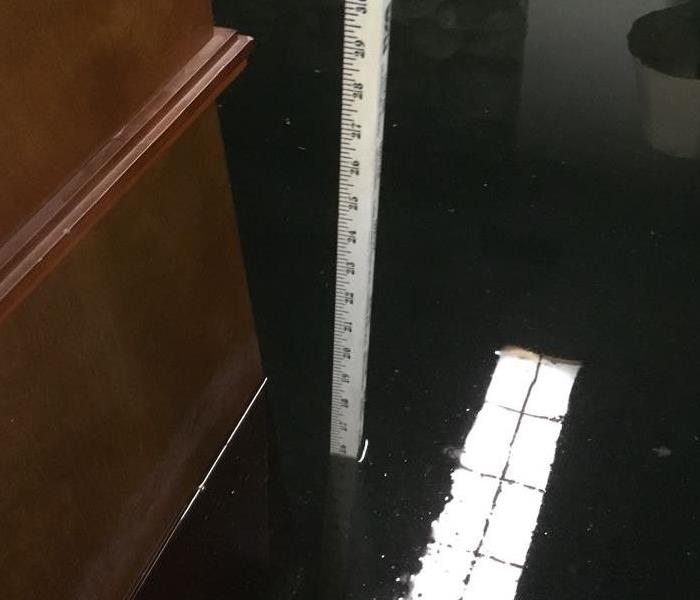 This house had two feet of water in the basement.
This house had two feet of water in the basement.
No one wants to walk into a room full of water, but it happens. What doesn't normally happen is an immediate reaction to save your belongings. Many customers feel so overwhelmed that they don't think of what to do first. We want to give you a list of things to do, so you can save as many belongings as possible.
1. STOP THE WATER! If you can't figure out where the water is coming from, then shut off the main water valve. Make sure that there is no more water coming into the room
2. SHUT OFF ANY AFFECTED UTILITIES. If water is coming through electrical outlets, make sure to turn the power to them off.
3. If you air conditioner and ducts weren't affected by the water damage, TURN IT ON for at least the first 24 hours to decrease the humidity.
4. Call SERVPRO of Blackfoot/Pocatello. We'll get a crew together to get out and help you start the next part of the process.
5. Get out the water. Using an extractor, water pump, and even buckets, get as much water out as you can.
6. Get all documents and photos that are water damaged, put them in a ziplock bag, and FREEZE THEM. It will help them be restored later.
7. Start washing all clothes, bedding, towels, and other linens that might grow mold. Getting them clean ASAP is going to save them later.
8. Remove everything that you can, but if you can't remove furniture, at least wrap the legs in foil to prevent more water damage or stains.
9. Leave the carpet alone. A restoration company will handle the carpet so that it can be saved or replaced, but insurance will want to see the carpet in place first.
10. Make sure you wipe all of the excess water from furniture and belongings. Get it off quickly to prevent damage.
SERVPRO of Blackfoot/Pocatello will help you with all of this, and then they will place fans and dehumidifiers throughout the room in a scientifically proven manner that will help dry your home out fast. Our experienced technicians know how to utilize the space and the air movement to take care of you. Then they will begin the process of removing all affected materials that might further get damaged.
We know having a flood is difficult, but we're here for you. Call us today at (208) 242-3819
Don't clean up water damage alone
6/21/2022 (Permalink)
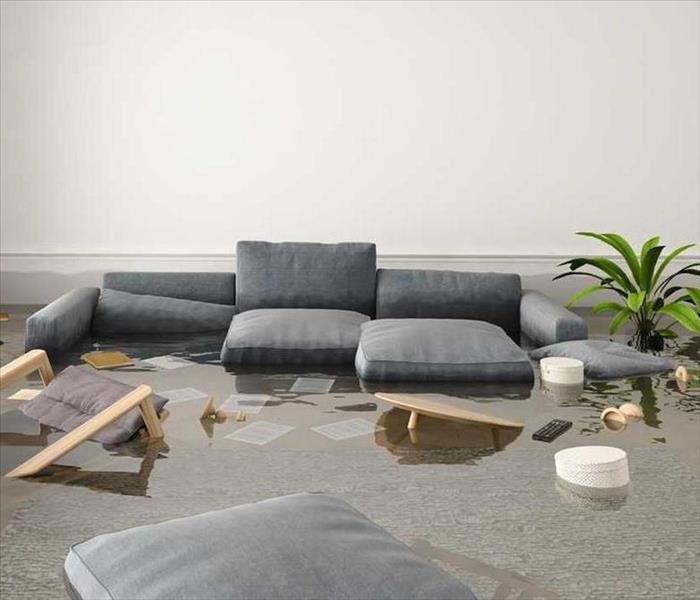 Call us if you ever find yourself holding a bucket to catch water in your home.
Call us if you ever find yourself holding a bucket to catch water in your home.
So you've had a flood in your house. Maybe the dishwasher backed up and your kitchen is flooded and running into your living room. Or your upstairs bathroom toilet clogged up and now you have water pouring through the ceiling into your basement. Most people don't think water is that big of a deal and as long as they can dry it out, things will be fine. Sometimes though, they're wrong. Here are a few reasons why you shouldn't try and clean your flooded home by yourself.
1. Mold. We all know that mold is the number 1 enemy after water damage, but most people don't really understand why or how mold affects our home. If you don't properly mitigate the situation, you're almost guaranteed to have mold growing in the porous materials of your floor, walls, and belongings. The walls may look and feel dry, but you can't see the other side, where the mold is growing, until it gets so bad that it comes through the wall.
2. Home Depreciation & Insurance Issues. Homeowners insurance is purchased for a reason. In the event of damage to your home, they will help you cover the costs. If you choose to clean up the damage yourself, you're going to understand why a restoration company matters. If by chance you've cleaned up a flood on your own without calling insurance, you aren't going to be able to file a claim later one. Any issue that might arise due to improper cleaning is no longer covered by insurance. That's a huge risk, if the damage is bad enough, and then the value of your home is going to decrease unless you pay to replace everything that could have been restored.
3. Warped floors and walls. This is the big one that usually makes people think twice after they've cleaned their own flood. It's not very noticeable at first, but after time your floors may start twisting and warping. Wood floors can be permanently damaged, drywall will deteriorate, and carpets can delaminate. If you try to dry out a flood without the proper equipment, it's going to take a lot longer and the humidity will do more damage than you realize.
4. Biohazards from contaminated water. I had a woman approach me yesterday to tell me that her laundry room was backing up. What caught me off guard was that she said "It's clean water, just from the washing machine, so it's not too bad." There is a big difference between clean water and contaminated water. If the water in your home is from a supply line, in most circumstances, it can be considered clean water, and there is a bigger likelihood of being able to restore almost all of the contents in the home if dried properly. Water that comes from the Drain-Waste-Vent System, in other words the water going OUT of your house, is absolutely not clean and it contains things like chemicals and biohazard waste in it. It might not look like sewage, but you're not going to want that to get on your skin or breathe it in, no matter what.
5. Risk of electric shock. If you don't have experience with working with electricity, let me tell you, getting shocked is not fun. When water is introduced to your electrical system, it can be deadly. If the water is in your walls, it's best to call in the professionals so you don't risk harming yourself.
If you need help, give us a call at (208) 242-3819 and SERVPRO of Blackfoot & Pocatello can be there in an hour.
Failed Wax Rings
12/23/2021 (Permalink)
There is a silent destroyer in many bathrooms that often goes unnoticed. A failed toilet ring can lead to some pretty messy issues, and their not just gross, but they're hazardous. Homeowners insurance often recognizes the damage from a failed wax ring when filing claims, so don't be afraid to get help if you see these red flags.
1. Look out for water pooling around the bottom of your toilet. That's the first sign that you have a leaky ring or broken flange.
2. The smell of sewer isn't normal in a bathroom, and typically that means that the airtight seal that should be at the bottom of your toilet is broken.
3. Water damage. If you're moving a toilet for any reason, there is a chance of contamination of the surrounding structure. If that toxic sewage water comes into contact with any other part of your bathroom, you need to have it cleaned properly. Not properly treating a bathroom with a sewage leak can cause mold and bacteria to grow at extremely fast rates, and it's dangerous for everyone in your home.
If you think you have w failed wax ring, give us a call at SERVPRO of Blackfoot/Pocatello and we'll see what we can do to help.
"Do you REALLY need to remove the drywall?"
11/10/2021 (Permalink)
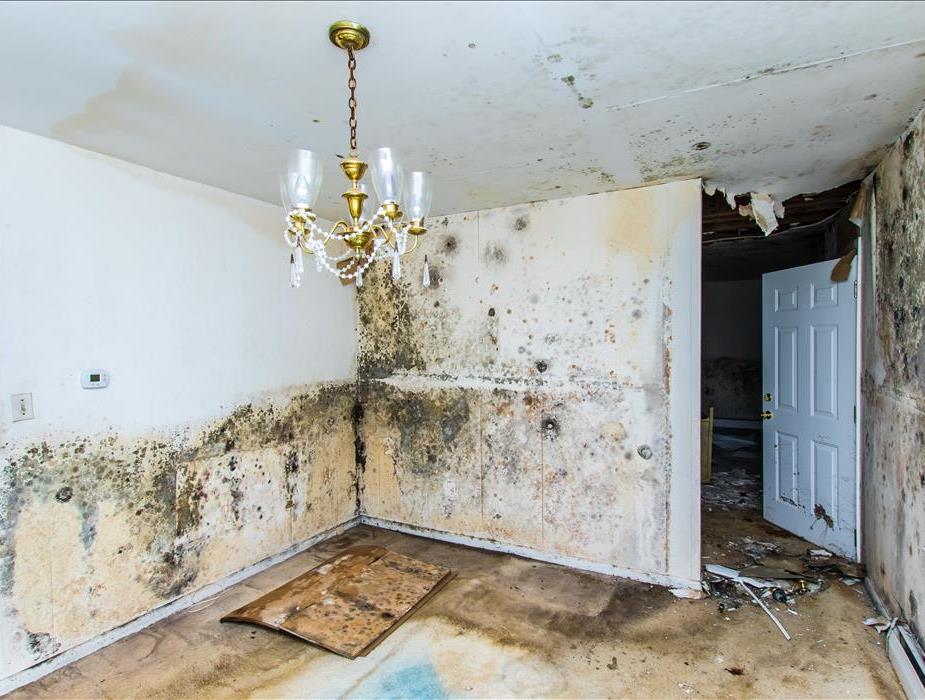 Room with water damage that wasn't removed.
Room with water damage that wasn't removed.
There are times when a pipe bursts under a sink, or the line to the ice maker gets a hole and you have a flood in your home of clean water. In those cases, if the water coming into your house is clean, and possibly even filtered. If you catch the flood soon enough before is soaks into things, you might get lucky. It may be possible to just dry your home as it is, but most often that isn't the case, because a lot of times the water that is flooding your home isn't clean water.
We get it, seeing your walls and floors removed is overwhelming and stressful, especially when you're concerned about your home and belongings. Homeowners often ask us why we recommend that drywall, carpet and padding, and other porous surfaces be replaced after a category 2 or 3 flood. After all, we're a "restoration" company so why don't we restore it as is? The reason is lying in the water.
When water seeps into your home, it often comes in contact with different contaminants that make the water unsafe and can make you sick. It spreads bacteria, fungus, chemicals and other possible gross things. That doesn't count where the water came from to begin with. Water that comes out of the dishwasher is full of soaps that can harm your skin or pets, and eventually can cause all sorts of things to grow in your floors, walls, cabinets, or furniture. The water itself may be able to just dry, but we have to think about what's in the water.
Let's not even talk about water that backs up into your home from the sewer... You REALLY don't want anything in that water lingering in your home or walls. Think about what's in your sewer, and then having that soak into drywall? :::SHUDDER:::
We almost always recommend that carpet, padding, and drywall be removed and replaced. We're thinking about what could grow in the future if it isn't removed. As for carpet padding, its very difficult to dry completely and the risk of mold is significant. Our experienced technicians will help you decide.
As a homeowner, it's always ultimately up to you how you'd like to proceed and how much you would like removed, but our IICRC technicians are highly trained for these kind of decisions.
Knowing Your Flood Risk
10/22/2021 (Permalink)
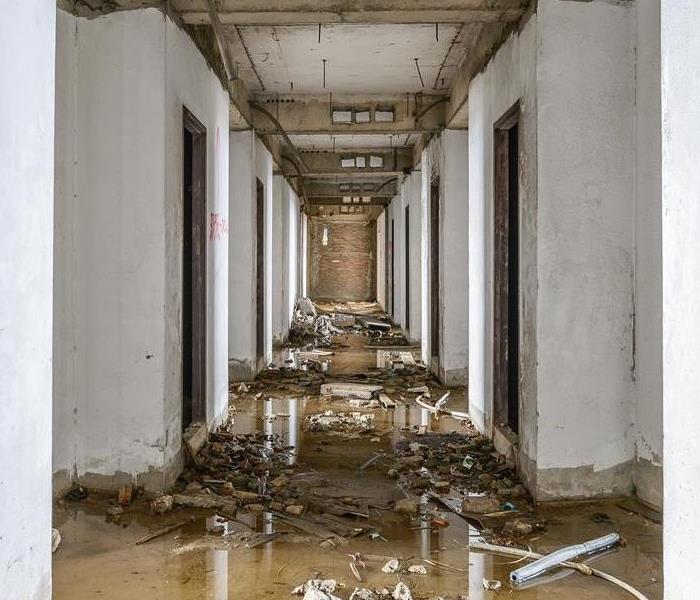 An abandoned flooded hotel.
An abandoned flooded hotel.
One of the ways that an insurance company dictates your coverage is the location of your home and the likeliness that a flooded waterway or wildfire will put your property in danger.
There is a FEMA website dedicated to letting you know if your home is in a flood zone. For example, our office is located in an area of minimal flood hazard.
PROPERTY LOCATED AT: 7057 S 5th, Pocatello, ID 83204FEMA FLOOD ZONE: X, AREA OF MINIMAL FLOOD HAZARD You can check your homes flood zone here- https://floodmap.floodsimple.com/ It's important to remember that a flood can happen anywhere. A rain storm can produce flash floods in almost any location, but a flood from a local waterway can be just as devastating. Making sure you understand the risk will allow you to make sure you have the right coverage for your home. Check out your address on the website and call your local agent to make sure you have the correct coverage for what your risk is.
It's Probably Not Black Mold
8/23/2021 (Permalink)
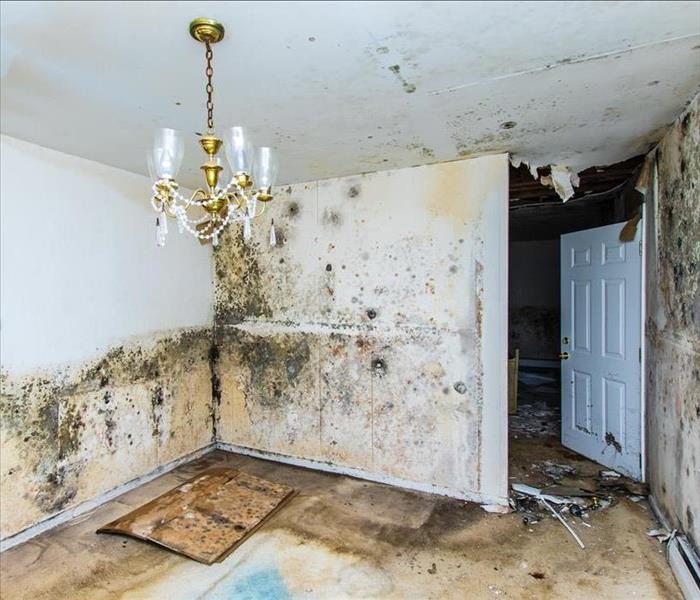 Water damage causing mold growth on the interior walls of a property.
Water damage causing mold growth on the interior walls of a property.
We get calls frequently from customers that claim to have black mold growing in their homes, asking us what it takes to treat it. While we are always happy to mitigate any mold issue in your home, the truth is, it's probably not Stachybotrys chartarum, which is the scientific name of black mold. There has also been significant amounts of debate on the toxicity of mold in general.
Logic can tell us that breathing in fungus is probably not good for our lungs, but it's not something that has to scare you. Studies have shown that most mold is irritating but not as dangerous as the media wants you to believe. So what does that mean for your home? It's still very important to clean up fungus in your home, because irritation and allergies can be harmful, but let's break down what you're looking at.
It’s important to figure out if you’re dealing with mold or mildew, and it's pretty easy to differentiate between the two. Mildew usually looks white or gray and dry or powdery. It always appears flat. Mold, on the other hand, usually looks slimy or fuzzy and is raised and can be green, red, blue, or black, typically the more colorful the more health effects. Mold also stains walls and furniture where mildew can be wiped off.
The major difference is that mildew can typically be cleaned with household products, but mold burrows deep into your structure and needs to be removed and properly cleaned so that it doesn't return. That's where SERVPRO of Blackfoot/Pocatello can step in. We will help you determine if you're dealing with mold or mildew, and have the testing to see what type it is. We can mitigate the problem and remove the moisture causing the growth, and we have products that not only clean and sanitize, but they also prevent it from growing back.
Call SERVPRO of Blackfoot/Pocatello at (208) 242-3819 to schedule an estimate to figure out exactly what you're dealing with.
What is Lurking in that Water Damage?
8/8/2021 (Permalink)
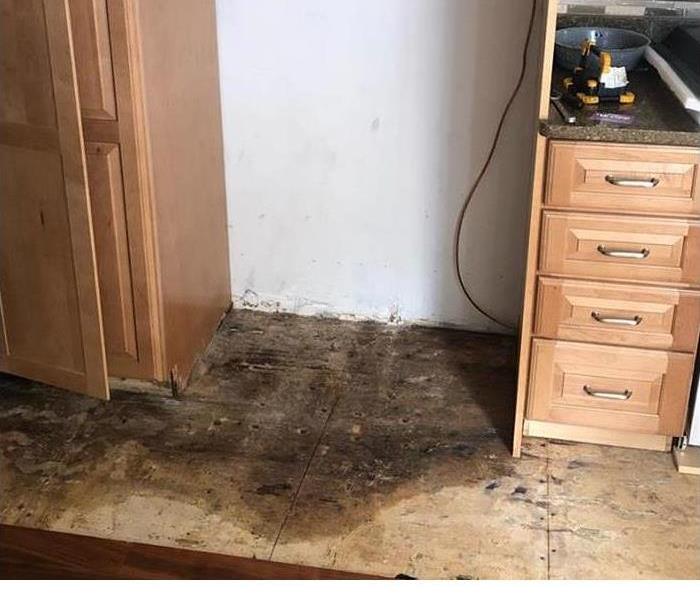 A refrigerator leak can cause significant damage if not treated quickly.
A refrigerator leak can cause significant damage if not treated quickly.
If you’ve ever had a flood in your home, you may have heard the term “category” followed by a number. For most homeowners, that doesn’t really mean a whole lot, but from a mitigation perspective, it means a whole lot.
Categories of water determine the process necessary to clean up and how careful you should be in dealing with the mess.
Three Types of Contamination
Category 1
There are three categories of water that can infiltrate your home or business. The first, Category 1, is sanitary water that typically comes from a broken pipe and doesn’t come in contact with any contaminants that could mix into it. It doesn’t pose a risk to your safety if you’re exposed to it, but can still easily cause mold if not treated immediately.
Category 2
This water contains significant amounts of contaminants that may cause harm to a person should they come in contact. Flooding from your washing machine into your home, or aquariums, or punctured waterbeds. This water could already harbor bacteria and shouldn't touch your skin and should quickly be taken care of to prevent further issues. After just two days, Cat 2 water damage can easily become a Category 3.
Category 3
This water is heavily contaminated by sewage. If water comes in from a sewer drain in any way, or back flows from the drains in your home, it requires extreme levels of caution. Toxins and pathogens are extremely harmful to humans and pets, and should be treated with the utmost care. Professionals should be wearing protective gear to clean up those messes.
Our expert team takes these situations very seriously. We have a response time of 1 hour or less to start the water damage repair process to keep it from spreading and worsening. We’re available 24/7 to protect your home, you, and your family.
Water Loss Tips
Water damages happen quite frequently, some of the most common causes that we see are from: failed supply lines from a toilet or fridge, water coming from outside the home, or leaks in the home bathroom.
When experiencing a water damage in your Pocatello home you should first:
-Shut off the water
-Call your insurance agent
-Call SERVPRO to begin emergency services
When dealing with a water loss from a clean water source which is considered to be a Category 1 loss. Most of your building materials that are wet can be salvaged and restored to preloss conditions. We have the ability to dry and salvage important documents due to water loss.
Helpful Tip
When shopping for a Home Owners Insurance policy a thing to consider is looking into a Flood policy. There have been many times that the cause of loss has been water from an outside water source. In result the insurance policy didn’t cover the loss and the owner was responsible for the cost.
Our team understands how stressful any type of loss can be. We pride ourselves on customer service and quick response times. All our technicians are background checked, drug tested, and are certified through the IICRC.
Their certifications range from Water Restoration Technician, Applied Structural Drying, Commercial Drying Specialist, and Applied Microbial Remediation Technician. Click the IICRC link to learn more about these certifications.
6 Steps to our Restoration Process
6/29/2021 (Permalink)
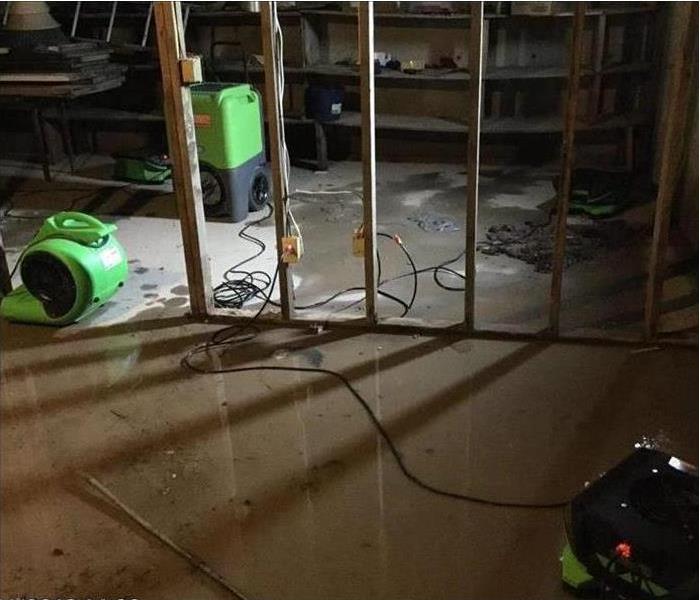 You can trust our process.
You can trust our process.
When you experience a flood, be sure the team you call in knows their stuff! We are highly trained and follow strict industry guidelines and we go through this 6 step process to make your water loss, "Like it never even happened."
Steps of Our Restoration Process
STEP 1- Emergency contact: Call us immediately
The restoration process begins when you call us. SERVPRO of Blackfoot/Pocatello is available 24/7/365 for water emergencies, large or small. When you are dealing with water damage, immediate action is crucial. Even a delay of a few hours can greatly increase the severity of the water damage.
When you call, we will ask several questions regarding your water damage emergency. These questions will help us determine what equipment and resources to bring, including how many trained water damage Professionals may be needed.
STEP 2- Inspection & Water Damage Assessment
When responding to a water damage emergency, we begin with a detailed inspection of your home or property, including a damage assessment. At this stage, our professionals are trying to determine the scope of the damage, so that we can develop an appropriate plan of action.
STEP 3- Water Removal/ Water Extraction
After the inspection and damage assessment step, the water extraction process begins. This step removes the majority of the water. We use powerful pumps and truck-mounted vacuum units to quickly remove hundreds or thousands of gallons of water from your property.
STEP 4- Drying & Dehumidification
Once the excess water has been removed, the floors and walls may appear dry, but a quick inspection will reveal they are wet to the touch. Nearly all building materials, like wood, drywall, and flooring materials, are porous and therefore retain water. This retained water can cause the materials to break down, warp, or cause mold damage.
STEP 5- Cleaning & Sanitizing
Your walls, flooring, and ceiling will most likely require professional cleaning services. In addition to cleaning your property’s structure, we will clean your furniture, upholstery, clothing, and other restorable belongings damaged by the water. Most flooding and water damage also require odor removal and deodorization since wet materials have a very distinct smell.
STEP 6- Restoration
The final step is the process of restoring your home or business to its pre-water damage condition. Restoration may involve minor repairs, such as replacing drywall and installing new carpet, or may entail major repairs, such as the reconstruction of various areas or rooms in a home or business.
4 Essential Features of a Large Loss Response
6/28/2021 (Permalink)
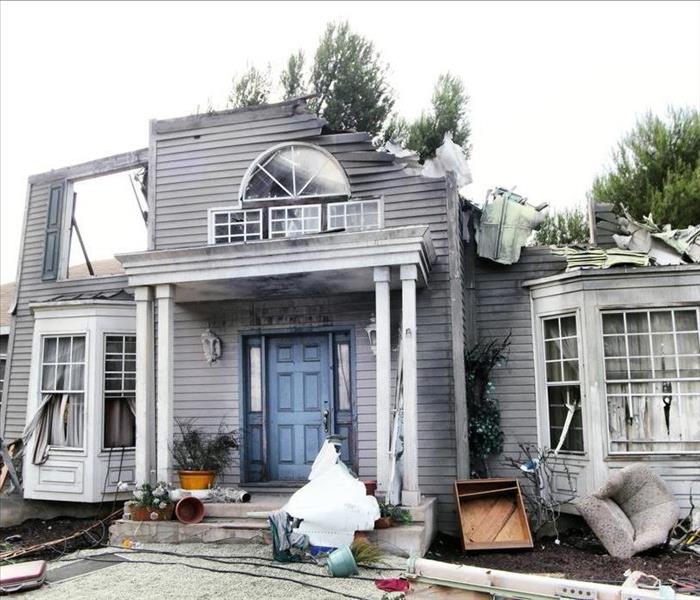 A home suffered loss.
A home suffered loss.
Typically, after a loss, such as a home fire or flood, you can count on your local Blackfoot, ID, restoration company to handle all your needs post-disaster needs. What happens during a catastrophic loss, though? Sometimes a large-scale tragedy, such as a wildfire or a hurricane, will affect a vast area and its many residents. When there's damage and destruction on a considerable scale, a large loss response team is essential. An LLRT is a restoration organization equipped to handle all aspects of a sizable disaster. This company must possess the appropriate expertise, labor and equipment. Victims of these types of disasters have great concerns already. An LLRT's mission is to seamlessly mitigate and restore the damage to minimize victims' worry.
LLRT Handles Large-Scale Losses
An LLRT handles large-scale losses by:
1. Creating a Custom Recovery Plan
Various clients, such as municipalities, government offices, commercial buildings, apartment buildings, and universities rely on an LLRT post-disaster. An LLRT will create a custom recovery plan based on the specific circumstances of the client and the unique details of the loss. For example, a large apartment complex that has suffered severe storm damage will be handled differently than a town that's sustained damage from flooding.
2. Providing Sufficient Manpower and Equipment
The LLRT is a team that is capable of handling all the different requirements associated with a catastrophic loss, such as the number of skilled workers and the necessary amount and type of equipment. The team also can work either by themselves or with a local franchise. SERVPRO is one such restoration franchise company that currently includes over 1,700 different franchises nationwide that can work independently or in association with others.
3. Equipping Victims With Necessary Services
They ensure that all necessary services are provided during disruptions. These services include power, water and sanitation.
4. Assigning a Liaison
The LLRT assigns a commercial operations manager to act as a liaison. This individual ensures everyone stays aware of the details throughout the restoration process.
A catastrophic loss has some unique needs that a smaller-scale disaster doesn't. An LLRT is always equipped to handle any type of emergency restoration on any scale.
4 Steps to Protecting Your Home After Water Damage
4/20/2021 (Permalink)
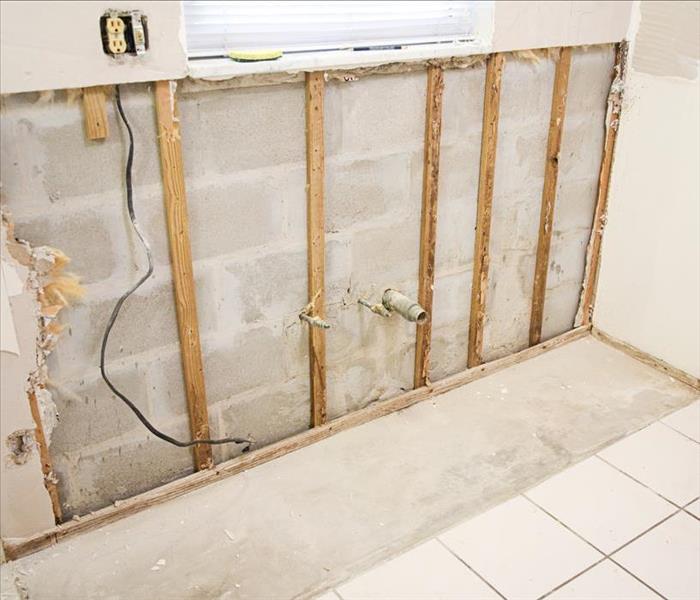 Contact professionals for water damage in your home.
Contact professionals for water damage in your home.
There are many possible causes for water in home, including flooding from outside and water damage from a broken pipe or other damage along your pipes. Whatever the original cause, as water spreads through your home, some of your most precious belongings can suffer damage. The steps you take right after the water recedes could mean either successful recovery or lasting damage:
4 Steps To Follow After Water Damage
1. Contact Professionals
The sooner cleaning and restoration professionals get to your Blackfoot, ID, home, the better your reconstruction efforts. It doesn't take long for water damage to spread; within just a day or two, mold may begin to set in. Additionally, floodwater isn't clean, and without the right cleaning techniques, your home may suffer from insect infestations, other pests, and lasting odors. In addition to cleaning pros, you should reach out to your insurance provider.
2. Remove Water and Dry Your Home
Once you've pumped or mopped out as much water as possible, begin drying off your furniture and other belongings. You may need to move some furnishings to a dry spot outside. Delicate fabrics and clothing may require dry cleaning or other professional efforts. Be aware that hardwoods, subflooring, and other parts of your home don't dry quickly. It may take days of effort before all water in home has been removed.
3. Separate Items for Cleaning and Disposal
Before you throw out cherished memorabilia, ask professionals about cleaning and repair steps. There are many techniques that can be used to save rugs, documents, artwork, and other valuable belongings.
4. Disinfect Your Home
After your home has been dried and your possessions fully cleaned, everything must be disinfected to prevent bacteria from infecting your belongings and the structure of the home. Trust professionals to appropriately apply disinfectants, so you can avoid damaging wood, fabric, and other textiles.
You can't always prevent water in home from spreading to your belongings, but you can take quick action to correct the situation. Remember that even a minor delay could lead to further, lasting damage.
All About Sewage Damage and Cleanup
3/29/2021 (Permalink)
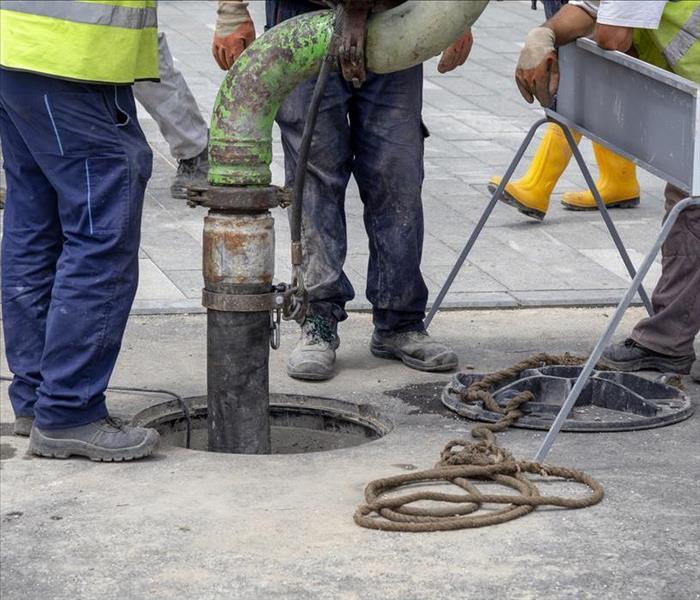 Call professionals to help with sewage remediation.
Call professionals to help with sewage remediation.
Sewer cleanup can be a daunting process. Dealing with the smell, water damage and various piping issues alone can make many homeowners run for cover. Fortunately, you are not alone, and you can prevent a large cleanup project by knowing what causes sewer damage and how it is corrected.
Facts About Sewer Damage and Cleanup
Causes of Sewer Damage
There are a few main things that cause damage to your sewer system. Some of these are:
- Flushing solid objects such as garbage, diapers, wet wipes and toys down the toilet
- Roots growing into the sewer lines
- Age cracking and breaking
- Defects such as collapsing lines and misaligned piping
- Septic or city sewer backup
These apply to both septic systems and city systems, so watch out no matter where you are. Most of these things are preventable with regular sewer maintenance and a bit of knowledge. Snaking your sewer lines, not planting trees over pipes and not putting anything but toilet paper in your lines are tasks you can do independently.
Sewer Cleaning
When things go wrong with your sewer lines, proper sewer cleanup is important. Raw sewage is extremely dangerous. It has bacteria in it that can hurt you if you attempt to clean the sewage yourself without proper precautions. This means using the proper suits, gloves and masks and disposing of the contaminated materials properly.
Sewage cleaning is more than simply dealing with a blocked sink or flooded toilet. You need to wear a protective suit, gloves, masks and eye protection. Sewage contains harmful bacteria and other contaminants that can make you sick. You also have to check the laws to make sure you are following the proper guidelines for disposal.
Calling in Help
With any major sewer issue, you are much better off calling in sewage remediation specialists in Blackfoot, ID. They will know the local laws, what to do and how to clean up the sewage properly.
Sewer cleanup is a long and difficult process if you don't know what you are doing. It is better to prevent damage than have to deal with the aftermath of a sewer line break.
How To Flush a Water Heater
11/25/2020 (Permalink)
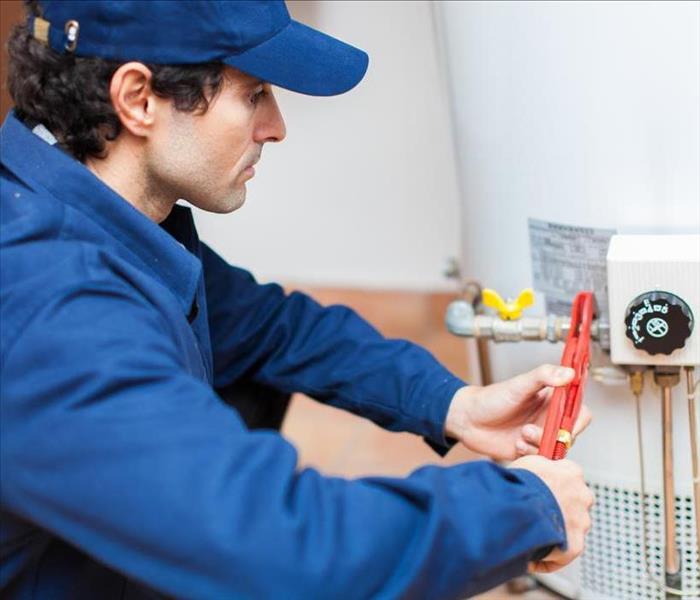 Flushing a water heater can resolve many minor issues
Flushing a water heater can resolve many minor issues
While every homeowner knows a water heater is essential to daily routines, few understand how resilient these appliances are. Too many people assume when hot water is no longer coming from the system that the heater is done, but that is not the case. Many minor issues can be resolved by flushing the system. To flush the system, you will need to follow a simple process and gather the necessary tools.
- Screwdriver
- Hose
- Drainage area
3 Steps to Flush a Water Heater
1. Turn of the Appliance
Before starting the water heater flush process, you will need to turn off the appliance. Do you have a gas or electric heater? If you have a gas system, you need to shut the gas valve and ensure the pilot is off before continuing. With an electric system, go to the circuit breaker box and flip the appropriate switch.
2. Drain the Tank
With the power off, you can connect the hose to the water heater. Before opening any valves, uncoil the hose and place the drainage end into your designated area outside. Then, to help empty the tank faster, turn on a nearby sink faucet, only the hot water supply. When ready, turn the flushing valve and the supply valve, allowing the water within the tank to flow out through the connected garden hose without refilling.
3. Resupply Water and Power
Once the tank is empty, which you will know from the lack of flow through the hose and the spatter of water from the sink, you can close the flushing valve and remove the garden hose. When ready, close the flushing valve and reopen the supply. With the tank full, go ahead and turn the power or gas back on.
If you run into any issues, do not hesitate to ask for help. There are several mitigation services in Blackfoot, ID, who can help fix your system.
A water heater is more resilient than many homeowners think. Do not assume the worst when the appliance acts up. Instead, try flushing the system.
4 Things Not To Do After a Flood
9/22/2020 (Permalink)
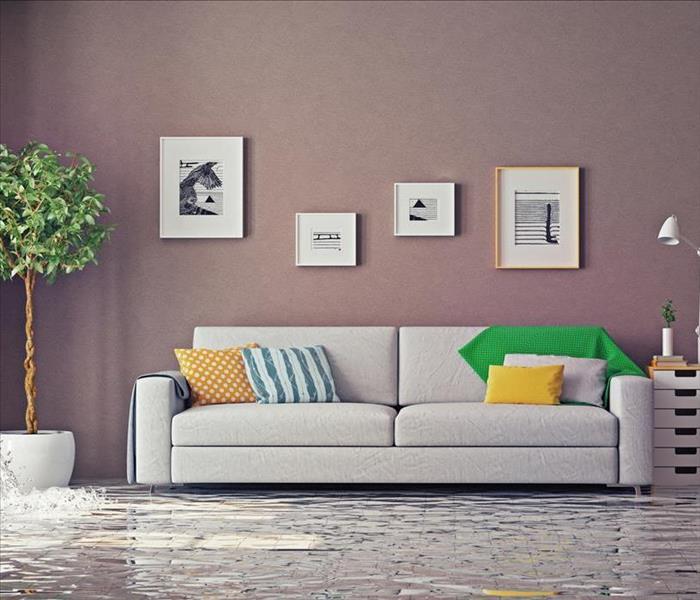 Call SERVPRO of Blackfoot/Pocatello when unwanted water from a flood or broken pipe invades your home.
Call SERVPRO of Blackfoot/Pocatello when unwanted water from a flood or broken pipe invades your home.
When unwanted water from a flood or broken pipe invades your Blackfoot, ID, home, one of the first things you should do is call your local water damage restoration company. While you wait for help to arrive, remain calm, stop the water source if it’s safe to do so, and avoid making a potentially dangerous mistake.
Avoid Making This 4 Dangerous Mistakes After a Flood
1. Don’t Enter Areas With Structural Damage
Water and building materials are like oil and water: They don’t mix. If you notice signs of structural destruction or decay, such as cracked, warped or sagging drywall or wood, leave that area alone until it can be surveyed by professionals.
2. Don’t Enter Areas With Electrical Damage
If you spot visible damage to wires or evidence of water in home electronics, steer clear not just of those items but the entire room. Instead, go shut off the power to the house.
While drywall and water don’t mix, electricity and standing flood water do. Because H20 is an outstanding conductor of electricity you should avoid operating any electronics or appliances while standing on wet carpets or other types of flooring as well.
3. Leave Sewage Water Alone
Sometimes, a toilet or a broken pipe in or near the bathroom is to blame for flooding. When this happens, leave any displaced dirty water alone. Water involved in this area of your home is likely filled with bacteria and other contaminants.
4. Don’t Try To Remove the Water With Your Vacuum
You should never try to suck up water with your regular vacuum. Doing so carries the risk of not only electrocution but also destroying the vacuum cleaner itself. If you have a wet/dry vacuum, however, that is typically safe to operate.
The next time your home suffers from a broken pipe or surprise spring flood, don’t panic. Enlist the help of a Blackfoot, ID, water damage mitigation company in order to restore normalcy as quickly and safely as possible.
Faster to your Water Damage Event
7/13/2020 (Permalink)
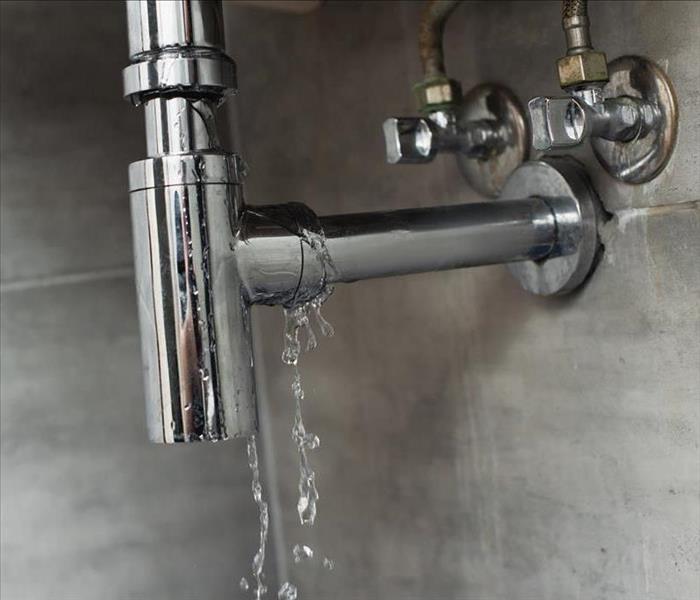 Leaking pipes can lead to severe water damage.
Leaking pipes can lead to severe water damage.
Flooding and water emergencies don’t wait for regular business hours and neither do we. SERVPRO of Blackfoot/Pocatello provides emergency cleaning and restoration services 24 hours a day, 7 days a week—including all holidays.
Faster To Any Size Disaster
Flooding and water damage is very invasive. Water quickly spreads throughout your home and gets absorbed into floors, walls, furniture, and more. SERVPRO of Blackfoot/Pocatello arrives quickly and starts the water extraction process almost immediately. This immediate response helps to minimize the damage and the cleaning and restoration costs.
Water Damage Timeline
Within Minutes
- Water quickly spreads throughout your property, saturating everything in its path.
- Water is absorbed into walls, floors, upholstery, and belongings.
- Furniture finishes may bleed, causing permanent staining on carpets.
- Photographs, books, and other paper goods start to swell and warp.
Hours 1 - 24:
- Drywall begins to swell and break down.
- Metal surfaces begin to tarnish.
- Furniture begins to swell and crack.
- Dyes and inks from cloth and paper goods spread and stain.
- A musty odor appears.
48 Hours to 1 Week:
- Mold and mildew may grow and spread.
- Doors, windows, and studs swell and warp.
- Metal begins to rust and corrode.
- Furniture warps and shows signs of mold.
- Paint begins to blister.
- Wood flooring swells and warps.
- Serious biohazard contamination is possible.
More Than 1 Week:
- Restoration time and cost increase dramatically; replacing contaminated materials and structural rebuilding may be extensive.
- Structural safety, mold growth, and biohazard contaminants pose serious risks to occupants.
About SERVPRO of Blackfoot/Pocatello
SERVPRO of Blackfoot/Pocatello specializes in the cleanup and restoration of residential and commercial property after a fire, smoke or water damage event. Our staff is highly trained in property damage restoration. From initial and ongoing training at SERVPRO’s corporate training facility to regular IICRC-industry certification, rest assured our staff is equipped with the knowledge to restore your property.
Preventing Frozen Pipes during the Winter
7/13/2020 (Permalink)
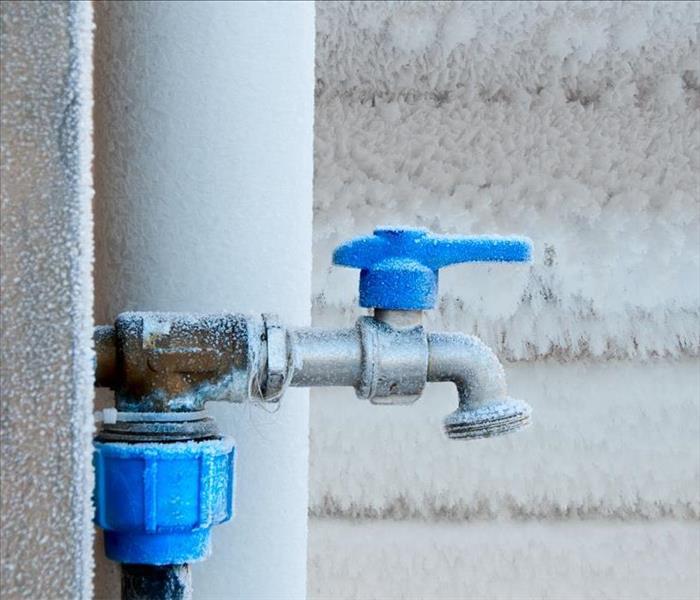 Frozen faucet outside of home.
Frozen faucet outside of home.
We believe that no one can be too prepared. Being prepared can help you avoid expensive issues of frozen pipes.
Follow these steps to Avoid Frozen Pipes
Before the onset of cold weather, prevent freezing of these water supply lines and pipes by following these recommendations:
- Drain water from swimming pool and sprinkler supply lines following manufacturer's or installer's directions.
- Remove, drain, and store hoses. Close inside valves supplying outdoor hose bibs. Open the outside hose bibs to allow water to drain. Keep the outside valve open so that any water remaining in the pipe can expand without causing the pipe to break.
- Check around the home for other areas where water supply lines are located in unheated areas.
- Consider installing specific products made to insulate water pipes like a "pipe sleeve" or installing UL-listed "heat tape," "heat cable," or similar materials on exposed water pipes. Newspaper can provide some degree of insulation and protection to exposed pipes – even ¼” of newspaper can provide significant protection in areas that usually do not have frequent or prolonged temperatures below freezing.
During Cold Weather, Take Preventative Action
- Keep garage doors closed if there are water supply lines in the garage.
- When the weather is very cold outside, let the cold water drip from the faucet served by exposed pipes. Running water through the pipe - even at a trickle - helps prevent pipes from freezing.
- Keep the thermostat set to the same temperature both during the day and at night. By temporarily suspending the use of lower nighttime temperatures, you may incur a higher heating bill, but you can prevent a much more costly repair job if pipes freeze and burst.
- If you will be going away during cold weather, leave the heat on in your home, set to a temperature no lower than 55° F.
To Thaw Frozen Pipes
- If you turn on a faucet and only a trickle comes out, suspect a frozen pipe. Likely places for frozen pipes include against exterior walls or where your water service enters your home through the foundation.
- Keep the faucet open. As you treat the frozen pipe and the frozen area begins to melt, water will begin to flow through the frozen area. Running water through the pipe will help melt ice in the pipe.
- Apply heat to the section of pipe using an electric heating pad wrapped around the pipe, an electric hair dryer, a portable space heater (kept away from flammable materials), or by wrapping pipes with towels soaked in hot water. Do not use a blowtorch, kerosene or propane heater, charcoal stove, or other open flame device.
- Apply heat until full water pressure is restored. If you are unable to locate the frozen area, if the frozen area is not accessible, or if you can not thaw the pipe, call a licensed plumber.
- Check all other faucets in your home to find out if you have additional frozen pipes. If one pipe freezes, others may freeze, too.
Future Protection
- Consider relocating exposed pipes to provide increased protection from freezing.
- Pipes can be relocated by a professional if the home is remodeled.
- Add insulation to attics, basements and crawl spaces. Insulation will maintain higher temperatures in these areas.
- For more information, please contact a licensed plumber or building professional.
Be wary of frozen pipes
7/10/2020 (Permalink)
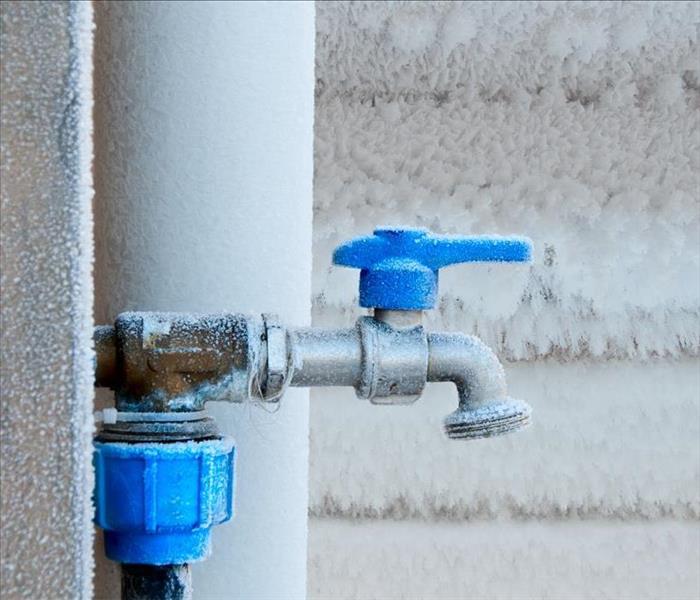 Pipes that are most likely to freeze are those that are the homes outdoor lines.
Pipes that are most likely to freeze are those that are the homes outdoor lines.
This winter has varied back and forth from being super cold to feeling like spring is just around the corner. With the interesting winter it came with a few joys of children playing in the snow and other outdoor activities. However, there are still plenty of dangers to look out for. Among these dangers are frozen pipes. Running water in your home can easily be taken for granted. When the water doesn’t seem to want to run through your faucets, it can leave a bigger impact on your personal home and place of business.
Pipes that are most likely to freeze are those that are the homes outdoor lines. These lines can be for something as simple as your sprinkler system pipes.
How to avoid frozen pipes?
To avoid pipes from freezing or bursting here are a few tips:
- Drain water from outdoor pipes before the cold weather arrives in your area
- Monitor your pipes in your kitchen and bathrooms but leaving cabinet doors open to let warmer air circulate.
- Add additional insulation, if needed.
Damaged Documents and Papers
7/6/2020 (Permalink)
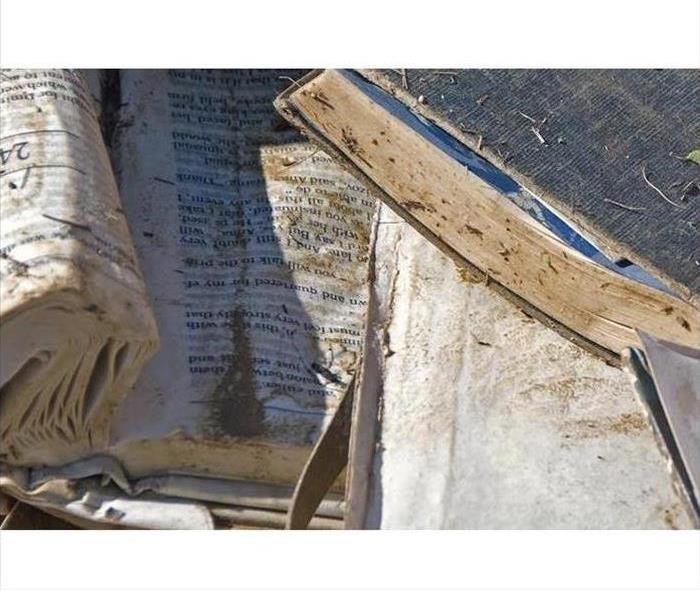 Water damaged books caused by a flood.
Water damaged books caused by a flood.
Devastated over your water damaged Family pictures or important papers?
SERVPRO Can Help With Damaged Documents and Papers
SERVPRO of Blackfoot/Pocatello can help! We can vacuum freeze-dry your special documents. You may want your damaged documents restored for sentimental or legal reasons. Often these documents are one-of-a-kind or are irreplaceable.
These important papers include:
- Family bibles
- Personal/Medical documents
- Government/business records
- Personnel files and blue prints.
SERVPRO of Blackfoot/Pocatelloo Document Restoration Service uses the process of sublimation. This process takes frozen documents through temperatures and pressures that turn moisture into vapor. The result is a dry document that can be restored or reused.
Water damage may occur when a basement floods, water damage from about or water from extinguishing a fire.
SERVPRO of Blackfoot/Pocatello will help you decide which documents to save and which ones to discard. We will box up, freeze and ship your damages papers with the care and security they deserve.
Be prepared for water damage!
3/9/2020 (Permalink)
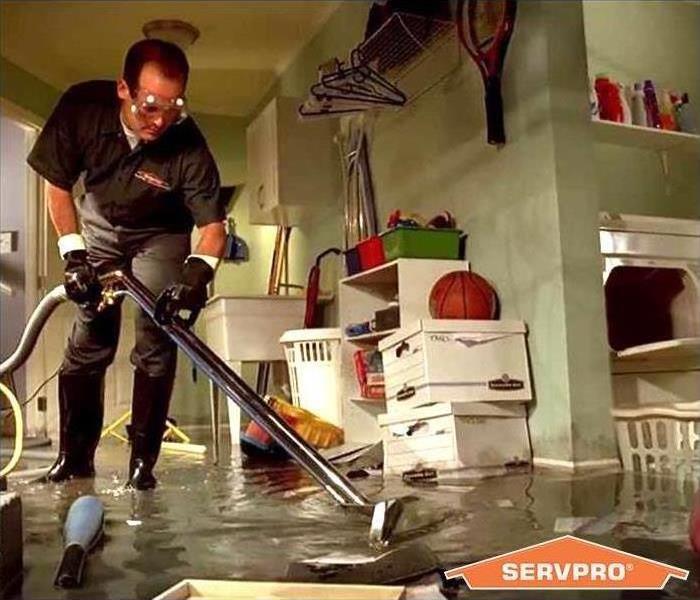 We are Here to Help® 24/7 in Blackfoot, ID
We are Here to Help® 24/7 in Blackfoot, ID
Disasters never wait for the right time to strike. Are you prepared if you experience a loss due to water?
Water Damages happen quite frequently, the most common causes we see are from, failed supply lines, water heaters, leaking toilets, fridges & dishwashers or water coming from outside the home, or storm damages.
What can you do to be prepared?
* Know where all your main shut off's are for your utilities!
1. Be sure that your Home Owners Insurance policy covers floods.
Many policies do not cover outside water source damages, from storms, irrigation systems, or city utilities lines. Call your Insurance agent, before you have a loss.
2. Have regular inspections done, on your homes systems.
Keep up on necessary maintenance on your water heaters, softeners, fridge/freezers, wash machines, and dishwashers. Clean/replace filters regularly and check for any leaks or seepage on hoses, change hoses regularly.
3. Keep gutters and downspouts clear of debris, that can cause overflowing or a back up of water.
4. Maintain trees & vegetation surrounding your home, so no unnecessary damages occur to foundations, gutters, window wells, water or power lines.
5. Regularly check your water pressure and keep a close eye on your water bill, for fluctuation in water usage.
We understands how stressful any type of loss can be. We pride ourselves customer service and quick response times. All our technicians are background checked, drug tested, and are certified through the IICRC. Their certifications range from Water Restoration Technician, Applied Structural Drying, Commercial Drying Specialist, and Applied Microbial Remediation Technician. Click the IICRC link to learn more about these certifications.
Have Questions about Water Damage?
Call us today!
How to prepare for your Insurance Adjuster.
7/16/2019 (Permalink)
Any type of water damage to your home or business can be overwhelming, the road to recovery and restoration can be difficult. However, knowing how prepare for a visit from your insurance company’s adjuster can make filing a claim simpler and get you the money needed to cover the cost of repairs without frustrating delays. See the following tips when to make this visit with your adjuster flow a little bit smother.
- Leave Items Where They Are: While you might be tempting to retrieve or dispose of damaged items from the water damage. It is a good idea to leave them where they are until the adjuster arrives. This will allow him or her to see everything in the existing damage state. If it is safe to do so take photos beforehand or take a video tour of the affected area. It may be difficult to face the damage; however, leaving your home untouched after a water damage can result in a more accurate repair estimate.
- Create an Inventory: Once the adjuster has stated that it is ok to begin the mitigation portion of the water damage and begin creating an inventory of damaged items and their worth. Include electronics, furniture or collections that have been appraised previously, such as sports memorabilia. Include prices if you can, but if any receipts have been destroyed by the flood, you can list amounts from memory or by pricing similar items. This is also something that we do at SERVPRO™ of Blackfoot/ Pocatello to relieve some of the hassle for you.
- Get Contractor’s Estimates: When filling your claim with your adjuster reach out to a few building contractors and get estimates for repair costs. Make copies of their findings and submit one to the adjuster so he or she can include it in the detailed report. When choosing to work with SERVPRO™ of Blackfoot/ Pocatello this is a step that we handle for you.
About SERVPRO of Blackfoot/Pocatello
SERVPRO™ of Blackfoot/Pocatello specializes in the cleanup and restoration of residential and commercial property after a fire, smoke or water damage event. Our staff is highly trained in property damage restoration. From initial and ongoing training at SERVPRO’s corporate training facility to regular IICRC-industry certification, rest assured our staff is equipped with the knowledge to restore your property
Have Questions about insurance process concerns? Call SERVPRO of Blackfoot/Pocatello Today – 208-242-3819
Common Causes of Water Losses
7/15/2019 (Permalink)
Water damages happen quite frequently, some of the most common causes that we see are from: failed supply lines from a toilet or fridge, water coming from outside the home, or leaks in the home bathroom.
When experiencing a water loss in your home you should first:
-Shut off the water
-Call your insurance agent
-Call SERVPRO of Blackfoot/Pocatello to begin emergency services
When dealing with a water loss from a clean water source, which is considered to be a Category 1 loss. Most of your building materials, that are wet can be salvaged and restored to preloss conditions. One thing that makes SERVPRO® of Blackfoot/Pocatello your premier restoration company, is that we have the ability to dry and salvage important documents due to water loss.
**Helpful tip**
When shopping for a Home Owners Insurance policy a thing to consider is looking into a Flood policy. There have been many times that the cause of loss has been water from an outside water source. In result the insurance policy didn’t cover the loss and the owner was responsible for the cost.
SERVPRO® of Blackfoot/Pocatello understands how stressful any type of loss can be. We pride ourselves customer service and quick response times. All our technicians are background checked, drug tested, and are certified through the IICRC. Their certifications range from Water Restoration Technician, Applied Structural Drying, Commercial Drying Specialist, and Applied Microbial Remediation Technician. Click the IICRC link to learn more about these certifications.
Have Questions about Water Damage?
Call SERVPRO® of Blackfoot/Pocatello Today – 208-242-3819
Detect a Water Leak Before it gets to Big.
7/15/2019 (Permalink)
Do you have a water leak? If water has been leaking in your home without you knowing once you notice the damage is usually extensive. Water leaks are not always easy to detect, sometimes the signs of water damage are hidden outside, behind a wall, under the floorboards, in a crawl space or attic, and behind appliances. No matter when it happened there are ways to detect the situation.
If you notice any of the below signs you might want to call SERVPRO® of Blackfoot/Pocatello (208)242-3819 to come and take a look:
- Water Accumulation- the most obvious sign is standing water
- Discoloration- watch for yellow-brownish water spots and stains on walls. You may also notice bubbling and cracking in the paint.
- Texture Changes- warping, buckling, sagging, sinking, and/or expansion in flooring
- Mold and/or Mildew- dark spots growing in corner and edges of walls and flooring
- Odor- moisture, humidity, and low circulation in the air cause mold and mildew to grow causing a musty odor.
SERVPRO® of Blackfoot/ Pocatello is well-versed in dealing with water damages. We have worked with commercial properties, as well as residents in removing water. Quick response times prevent the risk of secondary damages, like mold or mildew buildup. Using state-of-the-art moisture detectors, and thermal imaging technologies, along with our commitment to providing the very best service. We are here to ensure your water damage issue, is dealt with effectively and efficiently.
About SERVPRO® of Blackfoot/Pocatello
SERVPRO® of Blackfoot/Pocatello specializes in the cleanup and restoration of residential and commercial property after a fire, smoke or water damage event. Our staff is highly trained in property damage restoration. From initial and ongoing training at SERVPRO’s corporate training facility to regular IICRC-industry certification, rest assured our staff is equipped with the knowledge to restore your property, #likeitneverevebhappened.
Have Questions about Commercial/Residential Water Damage? Call SERVPRO® of Blackfoot/Pocatello Today! (208)-242-3819



 24/7 Emergency Service
24/7 Emergency Service






